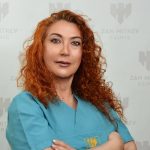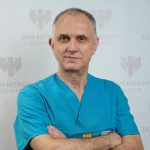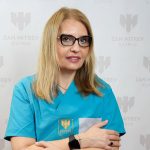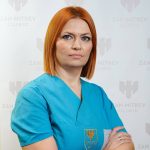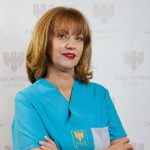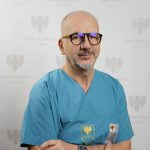 00389 2 3091 484
00389 2 3091 484
Medical services
Radiology
Breast diseases diagnostics
- Breasts ultrasound
- Digital mammography
- 2D and 3D mammography exam (tomosynthesis)
- Thin needle aspiration biopsy under ultrasound control
- Core biopsy under ultrasound control
- Breast MRI
- Surgical treatment of breast
Breast ultrasound
This method uses ultrasound waves to analyze the breast structure, detect cysts, inflammatory changes of the breast and it is also a starting method for diagnosing a breast cancer. The method is safe for pregnant women because it does not use X-rays.
Mammography
Mammography is a noninvasive radiologic method for examination of the breasts used to identify tumors and other changes which are too small to be palpated.
2D mammography – digital mammography which is a radiologic method with unlike the classic mammography has lower radiation dosage for the patient by around 30-40%, and by digitalization of the image it enables better visualization of microcalcifications and of the architectural distortion of the breast which makes it better in revealing breast cancer in its earliest stage.
3D mammography – tomosynthesis – reduces the number of falsely positive findings. Tomosynthesis is especially useful in women with dense breast tissue. It enables early detection of the carcinoma with clear image of the lesion and reduces the number of unnecessary biopsies.
Tomosynthesis may be performed as an additional imaging together with the conventional mammography or as an independent method. Tomosynthesis increases the possibility of detection of carcinoma by 30-40%.
Magnetic resonance of breast
Magnetic resonance is a noninvasive diagnostic method which is mainly used in women which are suspected or have already identified breast cancer using the previous diagnostic procedures and help in the assessment of the tumor size as well as in determination of the multifocality of the tumor and check the existence of tumor in the other breast.
Breast biopsy using ultrasound
Breast biopsy under ultrasound enables to locate the tumefaction and take a sample from the tissue for pathohistological analysis. It is less invasive than the surgical biopsy, leaves smaller of invisible scar and does not use ionizing radiation.
- Thin needle aspiration biopsy uses a very thin needle to extract a fluid or cells from the abnormal zone
- Core biopsy takes sample from the breast tissue by insertion

Osteodensitometry
Osteodensitometry is a sophisticated device that measures the bone density – how strong are the bones – and is the sole method to safely know whether you have osteoporosis.
It is especially used in women in postmenopausal period, once a year, in order to monitor the health of their bones. Osteodensitometry, in addition to the identification of the bone health, and the risk of fracture due to osteoporosis, monitors the treatment effect. DXA scanning focuses on two main areas – the hip and the spine. The procedure is safe, noninvasive and uses low levels of X-rays. The complete procedure lasts for 10-15 minutes.

Diagnostics with roentgenography and ultrasonographic examination
- Native X-ray of skeleton
- Native X-ray of lungs
- Native X-ray of abdomen
- Native X-ray of urinary tract
- Intravenous urography for visualization of the excretory system of the urinary tract
- Ultrasonographic examination (breast, thyroid gland, soft tissues and abdomen)

Computer tomography diagnostics (CT)
- Interventional procedures:
- CT led biopsies
- CT – PRT periradicular therapy
- CT – drainages
2. Diagnostic procedures:
- CT coronarography
- CT graft scanning
- CT of heart (diseases and congenital anomalies)
- CT of aorta
- CT angiography of carotid artery and cerebral arteries
- CT of peripheral arteries
- CT vein scanning (large veins)
- CT of skull and brain
- CT of thorax
- CT of abdomen and pelvis
- CT of skeleton in patients with polytrauma and/or tumors
- CT colonography (virtual colonoscopy)
- CT bronchoscopy (virtual bronchoscopy)

Diagnostics with magnetic resonance imaging
- MR of brain with diffusion and spectroscopy
- MR of hypophysis
- MR of orbits
- MR of the complete spine (cervical, thoracal and lumbar)
- MR of joints (sport injuries)
- MR of upper abdomen
- MRCP – cholangiopancreatography (gallbladder, biliary ducts and pancreatic canal)
- MR enterography (small bowel)
- MR urography
- MR of pelvis and hips
- MR of uterus and ovaria
- MR of rectum
- MR of prostate
- MR fistulography
- MR angiography (MRA) of cerebral and peripheral arteries
- MR of breasts
- MR of heart

Cardiac magnetic resonance
Cardiac magnetic resonance is a unique sophisticated method for characterization of the myocardium without radiation with or without using contrast.
Magnetic resonance of heart is used for diagnostics of many heart diseases, ischemic and nonischemic, in patients with various types of heart failure, in myocardial and pericardial inflammations, diagnostics of thrombi, heart tumors, congenital and acquired heart defects.
Protocols specific to any type of disease are used. Therefore, before heart magnetic resonance it is necessary to make an echocardiographic examination in order to identify the objective of the investigation.
The magnetic resonance of heart method is applied in the Zan Mitrev Clinical Hospital since 2018. Around 2000 investigations have been performed to date.
In the last several years, we also apply magnetic resonance of heart with perfusion in order to identify ischemic heart disease, viability of the myocardium, suggest the need for revascularization, as well as for assessment of the myocardial function.
In addition to the heart, this method is used to visualize the extracardiac structures in the chest and abdomen.
Magnetic resonance of heart is a team effort of the cardiologic technician, radiologist, cardiologist and certainly the patient. The investigation lasts for 30-45 minutes depending on the protocol and patient’s cooperation.
Magnetic resonance of the heart is a daily used method in the work of the cardiologists in the Zan Mitrev Clinic. This method enables detailed, comprehensive approach to each and every patient.

Angiography
- Phlebography
- Fistulography (cholangiography, HSG)
- Retrograde pyelography (RPG)
- Selective diagnostic peripheral and visceral angiographies
- Stenting of peripheral arteries
- Embolization
- TEVAR (thoracic endovascular aortic repair)
- ТАCE (transarterial chemoembolization)

Other doctor’s from this department
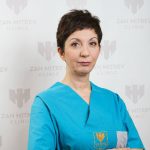
Lidija Veljanovska Kiridzievska MD
Specialist in radiodiagnostics
lidija.veljanovska@zmc.mk


